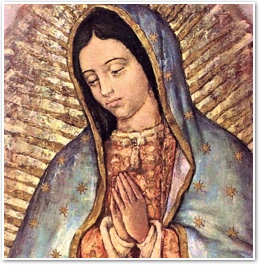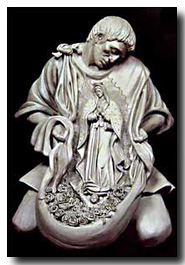Saint Juan Diego and Our Lady
- FR. WILLIAM SAUNDERS
The story begins in the early morning hours of December 9, 1531, when a 57-year-old Indian peasant named Juan Diego was walking along the path of Tepayec Hill on the outskirts of Mexico City.
 Keep in mind that only 10 years earlier, Hernando Cortez had conquered Mexico City. In 1523, Franciscan missionaries came evangelizing the Indian people. They were so successful that the Diocese of Mexico City was established in 1528. (Remember too that Jamestown, the first permanent English colony, was not established until 1607.) Juan Diego and many of his family members were among these early converts to the faith. He was baptized "Juan Diego" in 1525 along with his wife, Maria Lucia, and his uncle Juan Bernardino.
Keep in mind that only 10 years earlier, Hernando Cortez had conquered Mexico City. In 1523, Franciscan missionaries came evangelizing the Indian people. They were so successful that the Diocese of Mexico City was established in 1528. (Remember too that Jamestown, the first permanent English colony, was not established until 1607.) Juan Diego and many of his family members were among these early converts to the faith. He was baptized "Juan Diego" in 1525 along with his wife, Maria Lucia, and his uncle Juan Bernardino.
One must also not forget that Juan Diego had grown up under Aztec oppression. The Aztec religious practices, which included human sacrifice, play an interesting and integral role in this story. Every major Aztec city had a temple pyramid, about 100 feet high, on top of which was erected an altar. Upon this altar, the Aztec priests offered human sacrifice to their god Huitzilopochtli, called the "Lover of Hearts and Drinker of Blood," by cutting out the beating hearts of their victims, usually adult men but often children. Considering that the Aztecs controlled 371 towns and the law required 1,000 human sacrifices for each town with a temple pyramid, over 50,000 human beings were sacrificed each year. Moreover, the early Mexican historian Ixtlilxochitl estimated that one out of every five children fell victim to this bloodthirsty religion.
In 1487, when Juan Diego was just 13 years old, he would have witnessed the most horrible event: Tlacaellel, the 89-year-old Aztec ruler, dedicated the new temple pyramid of the sun, dedicated to the two chief gods of the Aztec pantheon Huitzilopochtli and Tezcatlipoca, (the god of hell and darkness) in the center of Tenochtitlan (later Mexico City). The temple pyramid was 100 feet high with 114 steps to reach the top. More than 80,000 men were sacrificed over a period of four days and four nights. While this number of sacrifices seems incredible, evidence indicates it took only 15 seconds to cut the heart out of each victim. (For more information, see Our Lady of Guadalupe and the Conquest of Darkness by Dr. Warren Carroll.)
Nevertheless, in 1520, Hernando Cortes outlawed human sacrifice. He stripped the temple pyramid of its two idols, cleansed the stone of its blood and erected a new altar. Cortez, his soldiers and Father Olmedo then ascended the stairs with the Holy Cross and images of the Blessed Mother and St. Christopher. Upon this new altar, Father Olmedo offered the sacrifice of the Mass. Upon what had been the place of evil pagan sacrifice, now the unbloody, eternal and true sacrifice of our Lord was offered. Such an action, however, sparked the all-out war with the Aztecs, whom Cortez finally subdued in August 1521.
Now back to our story. That morning Juan Diego was headed to Mass. As he walked along Tepeyac Hill, he began to hear beautiful strains of music, and he saw a beautiful lady, who called his name: "Juanito, Juan Dieguito." He approached, and she said, "Know for certain, least of my sons, that I am the perfect and perpetual Virgin Mary, Mother of Jesus, the true God, through whom everything lives, the Lord of all things near and far, the Master of Heaven and earth. It is my earnest wish that a temple be built here to my honor. Here I will demonstrate, I will manifest, I will give all my love, my compassion, my help and my protection to the people. I am your merciful mother, the merciful mother of all of you who live united in this land, and of all mankind, of all those who love me, of those who cry to me, of those who seek me, and of those who have confidence in me. Here I will hear their weeping, their sorrow, and will remedy and alleviate all their multiple sufferings, necessities, and misfortunes."
She told Juan Diego to go tell Bishop Zumarraga of her desire for a church to be built at the site. Tradition holds that Juan Diego asked our Blessed Mother her name. She responded in his native language of Nahuatl, "Tlecuatlecupe," which means "the one who crushes the head of the serpent" (a clear reference to Genesis 3:15 and perhaps to the prominent symbol of the Aztec religion). "Tlecuatlecupe" when correctly pronounced, sounds remarkably similar to "Guadalupe." Consequently, when Juan Diego told Bishop Zumarraga her name in his native tongue, he probably confused it with the familiar Spanish name "Guadalupe," a city with a prominent Marian shrine.
Bishop Zumarraga was a saintly man, very just and compassionate. He built the first hospital, library and university in the Americas. He also was the Protector of the Indians, entrusted by Emperor Charles V to enforce his decree issued in August 1530, stating, "No person shall dare to make a single Indian a slave whether in war or in peace. Whether by barter, by purchase, by trade, or on any other pretext or cause whatever." (Note that in 1537 Pope Paul III condemned and forbade the enslavement of the Native American Indian.) However, Bishop Zumarraga listened patiently to Juan Diego, and said he would reflect on the matter, understandably doubting such a story.
Juan Diego went back to Tepayac and reported the bishop's response. Mary instructed him to try again. So the next day, he did. Although this time it was more difficult to see the bishop, Juan Diego prevailed, and the bishop once more listened patiently. However, the bishop asked him to bring back a sign from Mary to prove the story. Again, Juan Diego reported the matter to our Blessed Mother, who told him to return the next day to receive "the sign" for the bishop.
On December 11, Juan Diego spent the day caring for his very sick uncle, Juan Bernardino. He asked Juan Diego to go and bring a priest who would hear his confession and administer the last rites. On December 12, Juan Diego set out again, but avoided Tepeyac Hill because he was ashamed that he had not returned the previous day as our Blessed Mother had requested. While making his detour, the Blessed Mother stopped him and said, "Hear and let it penetrate into your heart, my dear little son: let nothing discourage you, nothing depress you. Let nothing alter your heart or your countenance. Also, do not fear any illness or vexation, anxiety or pain. Am I not here who am your mother? Are you not under my shadow and protection? Am I not your fountain of life? Are you not in the folds of my mantle, in the crossing of my arms? Is there anything else that you need?" Mary reassured Juan Diego that his uncle would not die; in fact, his health had been restored.
 |
As for the sign for the bishop, Mary told Juan Diego to go to the top of the mountain and pick some flowers. He went up to the hill which was dry and barren a place for cactus and found roses like those grown in Castille, but foreign to Mexico. He gathered them in his tilma, a garment like a poncho. He brought them to Mary who arranged them and said to take them to the bishop.
Juan Diego proceeded again to Bishop Zumarraga's house. After waiting a while for an audience, he repeated the message to the bishop and opened his tilma to present the roses. The bishop saw not only the beautiful flowers but also the beautiful image of Our Lady of Guadalupe. Bishop Zumarraga wept at the sight of the Blessed Mother and asked forgiveness for doubting. He took the tilma and laid it at the altar in his chapel. By Christmas of that year, an adobe structure was built atop Tepeyac Hill in honor of our Blessed Mother, Our Lady of Guadalupe, and it was dedicated on December 26, 1531, the feast of St. Stephen the Martyr.
December 9 marks the feast day of Saint Juan Diego and December 12, the feast of Our Lady of Guadalupe.
 This is J. Fraser Field, Founder of CERC. I hope you appreciated this piece. We curate these articles especially for believers like you.
This is J. Fraser Field, Founder of CERC. I hope you appreciated this piece. We curate these articles especially for believers like you.
Please show your appreciation by making a $3 donation. CERC is entirely reader supported.

Acknowledgement
Saunders, Rev. William. "Saint Juan Diego and Our Lady." Arlington Catholic Herald.
This article is reprinted with permission from Arlington Catholic Herald.
The Author

 Father William Saunders is pastor of Our Lady of Hope parish in Potomac Falls, Virginia. He is dean of the Notre Dame Graduate School of Christendom College. The above article is a "Straight Answers" column he wrote for the Arlington Catholic Herald. Father Saunders is the author of Straight Answers, a book based on 100 of his columns, and Straight Answers II.
Father William Saunders is pastor of Our Lady of Hope parish in Potomac Falls, Virginia. He is dean of the Notre Dame Graduate School of Christendom College. The above article is a "Straight Answers" column he wrote for the Arlington Catholic Herald. Father Saunders is the author of Straight Answers, a book based on 100 of his columns, and Straight Answers II.


